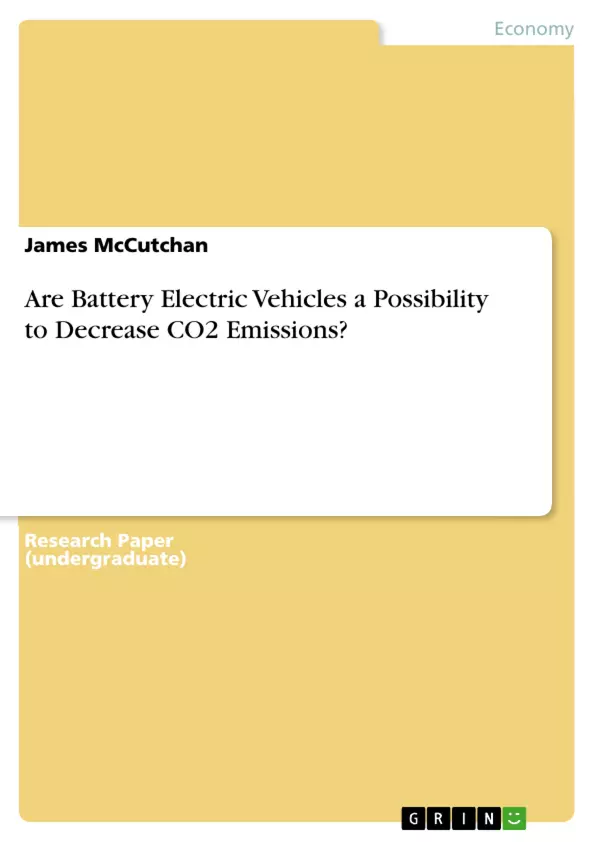With the number of vehicles on the world's roads expected to grow to 2.9 billion by 2050, steps must be taken to reduce the CO2 emissions from transport. Battery electric vehicles are becoming an increasingly pivotal way in which to curtail future road transport emissions.
This study aims to determine the CO2 emissions stemming from battery electric vehicles and to compare those CO2 emissions to the emissions from similar vehicles based on internal combustion engines. This study determines average passenger vehicle emissions in Melbourne, and models three common battery electric vehicles models. Manufacturer data was collected to determine battery electric vehicles modeled power consumption, as well as any efficiencies lost from charging and battery operation. Their energy consumption is combined with data on the CO2 intensity of the power generation mix in Victoria, modelling four different scenarios reflecting different carbon intensities of electricity generation.
The research aims to answer the questions, if battery electric vehicles models are able to deliver a meaningful decrease in CO2 emissions. For although battery electric vehicles do not produce any tailpipe emissions, they depend strongly on electricity production which is predominantly from non-renewable sources in Melbourne. This infers they are less 'green' than one may think, especially when taking into account life-cycle emissions such as from battery production and disposal.
This study looks at the relationship between energy consumption of battery electric vehicles and the CO2 emissions involved in generating electricity to charge them, and then compares this to the carbon emissions from comparable internal combustion engine passenger vehicles. This study also takes a look at modelling the possible future emissions reduction in the road transport sector by introducing battery electric vehicles into the existing fleet.
Frequently asked questions
What is the main focus of the study?
The study primarily aims to understand the indirect CO2 emissions arising from the operation of Battery Electric Vehicles (BEVs) and their power generation, comparing them with equivalent Internal Combustion Engine (ICE) vehicle emissions. It analyzes the potential of BEVs to reduce transport emissions considering the carbon intensity of electricity generation.
What are some key assumptions and limitations of the study?
The study is limited to a "tank-to-wheel" (TTW) analysis, excluding "well-to-tank" (WTT) or "well-to-wheel" analysis. It also assumes the manufacturer's quoted range for BEVs is accurate. The study also assumes that there were null CO2 emissions from these sources during electricity generation.
What data was used for ICE vehicle emission estimates?
The study used the Australian Bureau of Statistics' (ABS) 2016 Survey of Motor Vehicle Use, Australia as the primary source of traffic data. Data on average passenger vehicle emissions were also used to determine annual CO2 emissions in Melbourne and emissions per unit distance.
How was the power generation emissions data determined?
The CO2 emissions relating to the power generation mix in Melbourne were determined by calculating the CO2 intensity of the power generation mix. Data was gathered from the Department of Industry, Innovation and Science (2016), Department of the Environment (2015) and ACIL Tasman (2009). The study took the average emissions factor (AEF) and not the marginal emissions factor (MEF).
What is the average power consumption of BEVs considered in the study?
The study calculated an average effective energy consumption for BEVs based on manufacturer information for various models, including Tesla Model S, Tesla Model X, Nissan Leaf, BMW i3, Renault Kangoo Z.E., and Mitsubishi i-Miev.
What energy scenarios were modeled?
The study considered four energy scenarios for BEV charging: the existing Victorian grid mix, a 25% renewables mix, a 50% renewables mix, and a 75% renewables mix.
What were the findings regarding BEV emissions in Melbourne under the current energy mix?
The study found that if a BEV was charged using the equivalent of Victoria's 2014-15 energy mix, it could be responsible for more emissions than the current average new passenger vehicle, due to the high carbon intensity of Victoria's electricity generation.
What is the "50/50" and "75/75" case mentioned in the document?
The 50/50 case is modelled scenario where by 2030, there is a steady state of 50% adoption of both BEVs in the car fleet, and there is 50% renewable energy integration into the electricity grid mix. The 75/75 case is similar to the above except the BEV adoption and renewable energy integration targets are both set to 75%.
What future research is suggested?
The research suggests investigating the economic costs and benefits, as well as the feasible implementation of BEVs, specifically the price premium and feasibility of range requirements. It also suggest upstream/ downstream (lifecycle) analysis, rather than the tank-to-wheel analysis used in this report.
- Quote paper
- James McCutchan (Author), 2017, Are Battery Electric Vehicles a Possibility to Decrease CO2 Emissions?, Munich, GRIN Verlag, https://www.grin.com/document/375235



